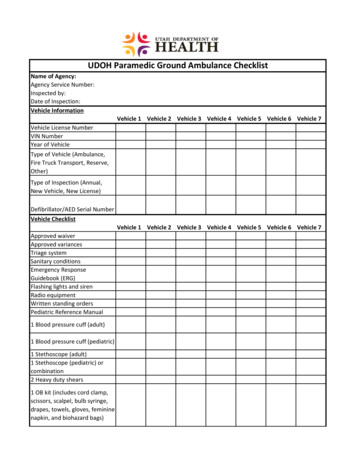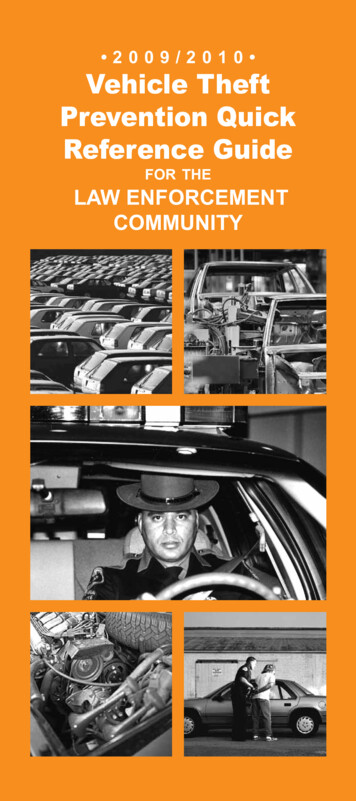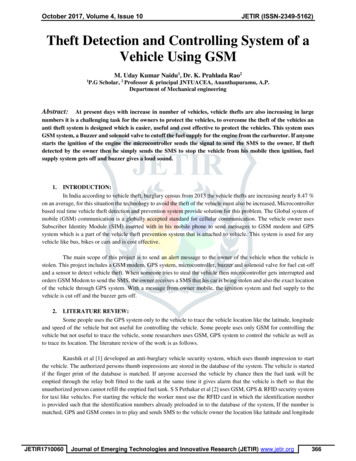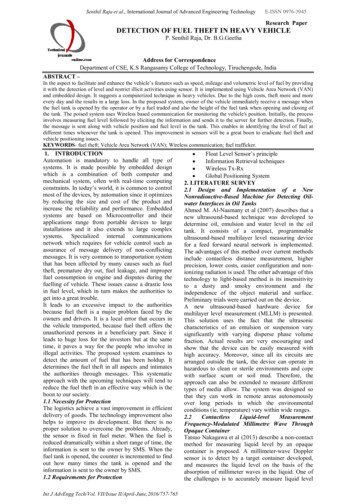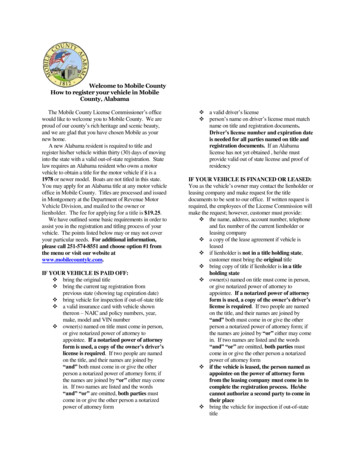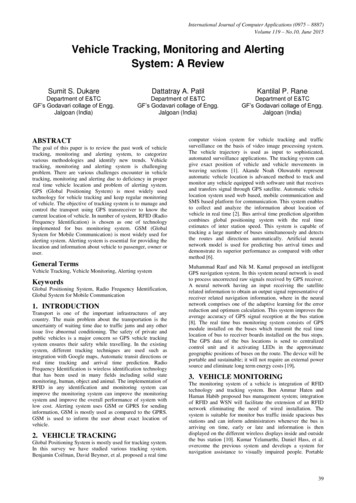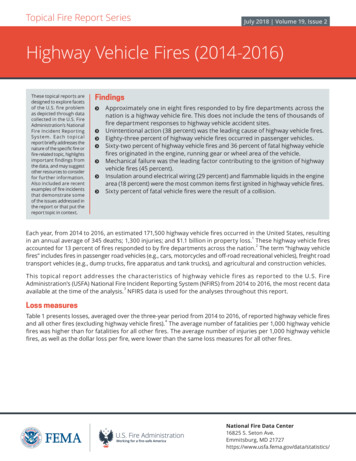
Transcription
Loss prevention standardsVehicle SecurityDespite modern day security enhancements,vehicle theft remains a threat with criminalsdeveloping sophisticated new methods. Butmeasures can be taken to prevent this andminimise the risk.Aviva: PublicAviva: Public
Vehicle SecurityIntroductionHome Office figures have highlighted a 50% rise in vehicle theftsover the last five years. Figures from the Association of BritishInsurers (ABI) show that the number of motor theft claims are attheir highest since 2012, with a payment made to a vehicle crimevictim every eight minutes. In the last four years the overall cost ofmotor theft claims has doubled and works out at over 1.2 millionpaid to policyholders every day.Whilst the more traditional methods of theft, such as breakingwindows and forcing door locks are still prevalent, vehicle security has improved substantially over the last 30years. Vehicles have become more sophisticated and less reliant on physical security and as a result, criminals areincreasingly utilising methods to overcome electronic security and keyless entry. The rising number of thefts inpart, reflects the vulnerability of some vehicles to keyless relay theft. Also, as vehicles get smarter and we movetowards autonomy, cyber security is an emerging risk for motor manufacturers, insurers and end users, due to thethreat of hacking and data theft. Mobile phone apps now include many features and settings, allowing the user tocontrol the vehicle from a mobile phone, again potentially increasing the risk of theft if not properly managed. Thefuture is likely to see the use of biometrics, such as fingerprint technology and face recognition for authentications to enhance security.Passive keyless entry systems, which allow vehicles to be opened and driven so long as the key fob is in thecan capture the signal from the key fob, allowing the vehicle to be unlocked and consequently stolen withinminutes.Thatcham ResearchEstablished by the motor insurance industry in 1969, Thatcham Research is the UK motorresearch centre. Against a backdrop of rising car crime, Thatcham Research has launched a security rating to helpconsumers better understand the theft risk of new vehicles. The ratings assess whether security measures toaddress a vulnerability in keyless entry/start systems, have been introduced by manufacturers. Vehicles are ratedlay attackTheft PreventionWhilst vehicle security research by manufacturers and industry bodies continues, policyholders can also takepreventative measures to ensure that the risk of vehicle theft is reduced, such as: Vehicle keys should be kept in a secure position at all times and not left within easy reach If you have a keyless entry vehicle:omake sure your keys are kept well away from doors and windowsLOSS PREVENTION STANDARDSAviva: Public
ooconsider the use of a signal blocking pouch, also known as a Faraday bag, to store the keys in when thevehicle is not in use. The pouch will prevent thieves from being able to amplify the signal used in relaythefte wireless signal; turning off thesignal will also prevent relay attack keys reprogrammed. Whilst this may be an expensive option, it could prevent theft of the vehicle. The MasterLocksmiths Association should be able to help with thisConsider fitting additional security devices to the vehicle, such as steering wheel locks, alarms and trackingsystemsPark the vehicle securely in an area that is less vulnerable and ideally secure and well-litAvoid leaving items in the vehicle and on view that are theft attractiveEnsure that any vehicle functionality controlled by a mobile phone app is regularly updated in accordance withmanufactureCatalytic Converter TheftMany modern vehicles are fitted with a catalytic converter, which uses catalyst substances to clean up harmfulgases from the engine before they exit the exhaust pipe. Inside its metal casing there are usually two ceramic blocksmade up of thousands of micro cellular channels which resemble a honeycomb. The surfaces of these ceramicblocks are coated with precious metals such as platinum, palladium and rhodium, therefore making them theftattractive. Whilst there is an on-going exposure to catalytic converter theft, this tends to ebb and flow in accordancewith scrap metal prices. Drivers can be unaware that the converter has been stolen, with the main symptoms beingan increase in exhaust noise and a lack of vehicle performance.Measures that can be taken to prevent catalytic converter theft include: If possible, park the vehicle in a locked building or compound when unattended -lit area as close to your property as possible Consider installing a Thatcham approved alarm to your vehicle; ones that activate if your vehicle is lifted ortilted are particularly effective Use a catalytic converter protection device or marking systemSelectamark are the Aviva Specialist Partner for approved DNA marking systems.Light Commercial Vehicles (LCVs)Research from Volkswagen Commercial Vehicles suggests that theft from and of light commercial vehicles has alsoincreased by 45% over the last four years. Whilst also increasing insurance premiums for operators, the theft of avan could have a significant impact on the day to day running of a business.Further prevention methods for van operators include: Window guards or full internal bulkheads, to prevent would-be thieves seeing insideLOSS PREVENTION STANDARDSAviva: Public
Fitting additional locks to rear and sliding doors to help deter thievesInvesting in lockable internal racking or secure storage boxes for your most valuable toolsAlways storing your tools elsewhere overnightEnsuring you have the right insurance for your needs private van insurance, commercial van insurance, hire &reward, etc. Considering an ECU guard or OBD port protector to prevent unauthorised access to the vehicles managementcontrol systemsMaple Fleet Services are the Aviva Specialist Partner for approved light commercial vehicle security solutions.Large Commercial VehiclesWhilst the theft of larger commercial vehicles is less prevalent although still a concern, the theft of fuel and goodscarried on the vehicle represents a significant exposure for operators. LGVs are particularly vulnerable when parkedon industrial estates, service stations and laybys. Drivers should be made aware of criminal traps, where thieves willtry and stop drivers while they are driving or delivering by using various ploys, such as staged accidents, orimpersonating police officers/officials.The risk of theft can be reduced by: Never leaving the vehicle with the key in the ignition and the engine running, unless a key-out immobiliser isfitted Utilising pre-planned, approved overnight parking facilities and avoiding laybys and remote industrial estateswhere possible Not allowing drivers to give lifts, or to have any unauthorised people in the cab. In addition to the securityaspect, the carriage of unauthorised passengers could result in a third party personal injury claim against yourfleet policy Only stopping for marked police/DVSA vehicles with uniformed occupants. If in doubt, ask for identification Reviewing the security procedures at your operating centre(s) Considering kingpin or airline locks to protect unaccompanied trailers Considering fitting an anti-syphon device to fuel tanksMotor TradersPolicyholders dealing with the sale, service and repair of vehicles should ensure that robust policies and proceduresare established to ensure the security of vehicles under your control. This is of particular importance when itinvolves the custody of a number of vehicles, with various members of staff having access to vehicle keys: Vehicle keys should not be left in areas that are accessible by the general public and should never be left on anopen key board Key access should be restricted to designated employees and key cabinets must be kept closed at all timesunless removing or replacing keys Review your security procedures, giving consideration to lighting, CCTV, security hoops and entrance barriersLOSS PREVENTION STANDARDSAviva: Public
Insafe are the Aviva Specialist Partner for approved key cabinets.Parked/Stored Vehicles Accumulation RiskAs part of your normal security and also business interruption plans, consideration should be given to theintroduction of additional measures for occasions whereby a larger number of vehicles may be parked or storedtogether in one place for a prolonged period; examples of this would include public holidays or any unplannedevent, such as a pandemic.Having a larger than normal accumulation of vehicles could lead to the increased risk of vandalism, theft, fire, floodor other single impact events. Vehicles should be locked: Parked as far away from buildings and combustible materials (e.g. pallets, etc.) as possible:Consider if any exposing buildings or materials caught fire could this spread to the vehicles, andvice versa? Parked with sufficient space between them to prevent the spread of fire:oooIf this is not possible then consider small clusters of vehicles with appropriate aisles and roadwaysConsider the number and value of the vehicle clustersIf vehicles are to be parked inside a building or warehouse, then the keys should still be removed and returned andstored in an appropriately secure location(s).Unless there is risk to life, it is unlikely that the Fire & Rescue Services will remove any vehicles from a burningbuilding. Consider the implications of having all the keys in the same location or secure area:ooooWhat is the total number or value of vehicles exposed with the keys stored in a single location?Should the number or value of the vehicles drive multiple secure locations for the keys?Is the secure location/safe fire resistant?hicles? A simple key safe is not considered appropriateSecurity measures should be risk assessed: For effectiveness, based on geographic location and surrounding areas; topography; value; number and natureof the vehicles Are fences appropriate? Is lighting appropriate? Are there any vehicle movement prevention devices that can be employed, e.g. bollards or temporary large scaleconcrete blocks? It may be necessary to employ temporary static guards and/or to increase the frequency of any roaming securityvisits Wherever possible, tools, equipment and personal effects should be removed from vehicles and stored securelyLOSS PREVENTION STANDARDSAviva: Public
Have you and your surrounding community/neighbours, discussed the implications of any restrictedmovements during such periods (e.g. Coronavirus), and considered sharing security resources, costs andincluding each other in a wider security approach/plan?If the vehicle has a battery isolation switch, then this should be turned off, to remove the risk of an electrical faultcausing a fire.Finally, consideration should be given to the natural catastrophe exposures of storing vehicles together in a singlelocation: Flood both from a nearby water course or a sudden torrential downpour Hail WindstormFurther guidance on flood can be found in the Aviva Loss Prevention Standard UK Flood Guidance and Mitigation.ChecklistA generic Vehicle Security Checklist is presented in Appendix 1 which can be tailored to your own organisation.Additional Information SelectamarkMaple Fleet ServicesInsafeThatchamTo find out more, please visit Aviva Risk Management Solutions or speak to one of our advisors.Email us at riskadvice@aviva.com or call 0345 366 6666.**Calls may be recorded and/or monitored for our joint protection.LOSS PREVENTION STANDARDSAviva: Public
Appendix 1 Vehicle Security ChecklistLocationDateCompleted by (name and signature)Vehicle Security Checklist1.Is there a formal vehicle security procedure in place for all locationsto ensure vehicles and keys are safe and secure at all times?2.Are there documented inspections at the locations to verify thatthe vehicle security procedure is in place and being followed?3.Following a vehicle(s)/key(s)/vehicle parts theft is an investigation4.Has guidance been provided to all employees on the safe storage ofkeys (including keyless entry vehicles)?5.Do the keys need to be reprogrammed for second-hand vehicles orwhere both sets of keys are not present?LOSS PREVENTION STANDARDSAviva: PublicY/NComments
Vehicle Safety Checklist Cont.6.Have further prevention measures being considered to preventtheft/access to the vehicle, such as: Window guards or full internal bulkheads?Fitting additional locks to rear and sliding doors?Investing in lockable internal racking or secure storageboxes for your most valuable tools?Storing your tools elsewhere overnight?Fitting:o an ECU guard or OBD port protector?o kingpin or airline locks to protect unaccompaniedtrailers?o an anti-syphon device to fuel tanks?o a catalytic convertor protection device?7.Is the vehicle security procedure adhered to when purchasing newvehicles?8.Is the vehicle security procedure reviewed on an annual basis?9.Has the accumulation risk been considered and quantified foroccasions where there is a larger than normal number of vehicles?Has this been notified to your broker and/or insurer?10.Does the site traffic plan allow for additional vehicles to be parkedon site?Can this be completed safely?11.Have the security implications of having a larger number thannormal of vehicles housed together been assessed?Are there additional remedial measures needed or planned?12.Have all the vehicles been locked?LOSS PREVENTION STANDARDSAviva: PublicY/NComments
Vehicle Safety Checklist Cont.13.Are the vehicle keys housed or stored in a detached or remotesecure location, appropriately arranged for the value or number ofvehicles?14.Is an additional physical security presence required?Full time, or for a short or temporary basis?Roving both day and night?Are informal visits required by site personnel or management tosupplement this?15.Have any fire risk assessments been revised to include occasionswhen the premises have a larger than normal number of vehicles?Does this consider: 16.Statutory requirements?Property and business impact assessments?Fire spread and methods of firefighting?Are the vehicles stored as far away from buildings and combustiblematerials as possible?Ideally this should be at least 10m.17.Are the vehicles stored in groups with appropriate aisleways orbreaks to minimise fire spread and assist firefighting?18.Is the area used to store vehicles considered to be vulnerable toflooding? 19.From a body of water?From torrential rain/downpour?Is the removal of the vehicles to a less exposed location consideredas part of any flood response plan?LOSS PREVENTION STANDARDSAviva: PublicY/NComments
20.Additional comments:Please NoteThis document contains general information and guidance only and may be superseded and/or subject to amendment withoutPrevention Standards), and nor shall any third party rely on them. Other than liability which cannot be excluded by law, Avivashall not be liable to any person for any indirect, special, consequential or other losses or damages of whatsoever kind arisingout of accessexposure or hazard that may arise and Aviva recommend that you obtain specific advice relevant to the circumstances.08/04/20 V1.2Aviva Insurance Limited, Registered in Scotland Number 2116. Registered Office: Pitheavlis, Perth PH2 0NH.Authorised by the Prudential Regulation Authority and regulated by the Financial Conduct Authority and the Prudential Regulation Authority.LOSS PREVENTION STANDARDSAviva: Public
1. Is there a formal vehicle security procedure in place for all locations to ensure vehicles and keys are safe and secure at all times? 2. Are there documented inspections at the locations to verify that the vehicle security procedure is in place and being followed? 3. Following a vehicle(s)/key(s)/vehicle parts theft is an investigation 4 .
